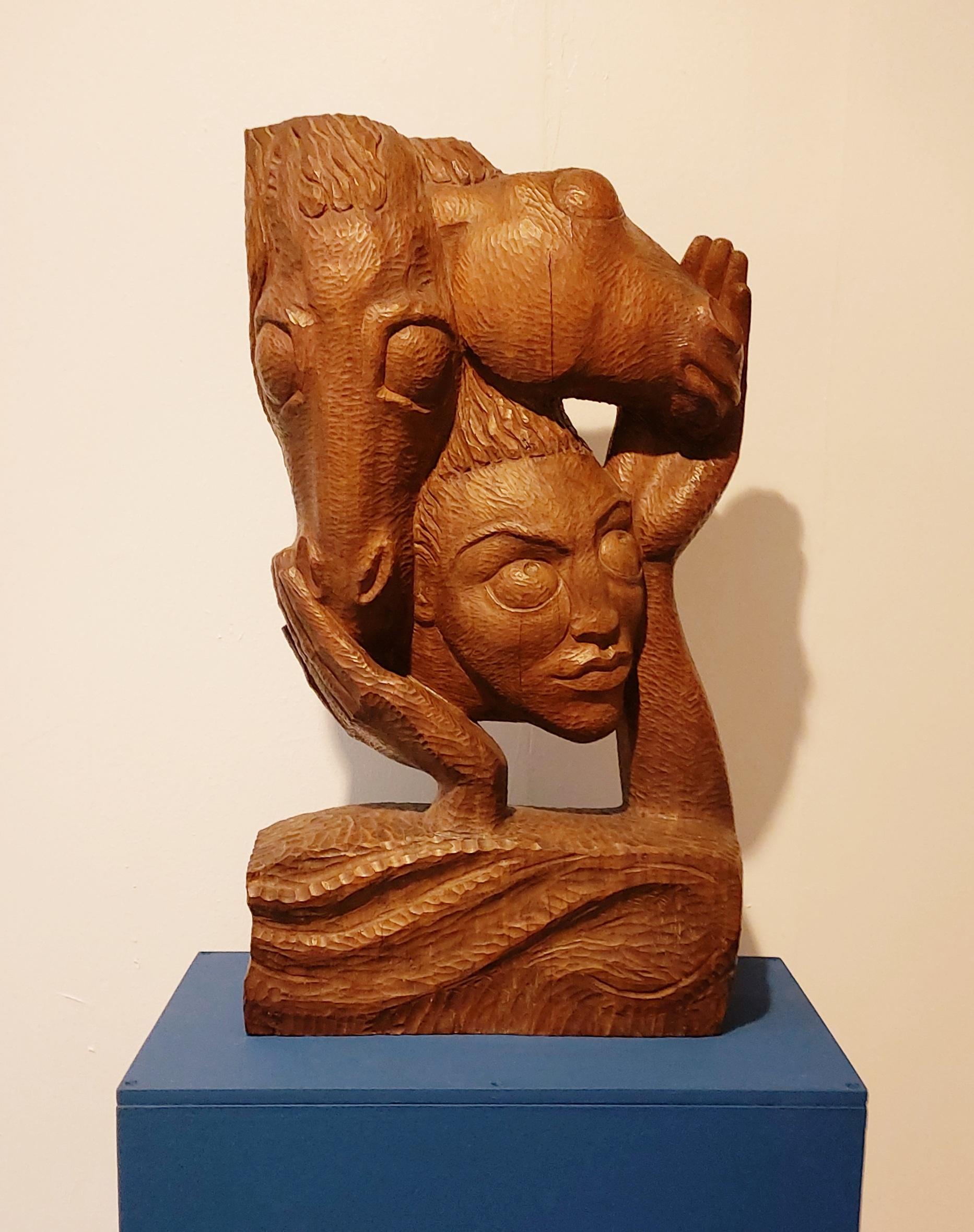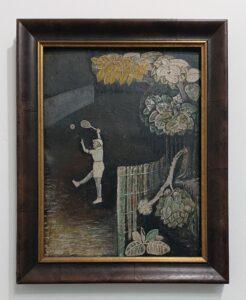Recent donations or “Narrative Evolutions”?

Part 1
It appears that my 23 April 2023 column, What About the Summer Exhibition?, helped to stir some action on the part of the National Gallery of Jamaica (NGJ). On 9 May, it published a set of flyers on social media, in which its exhibition programme for the rest of the year was finally announced. This programme, it turns out, consists of two exhibitions: one of recent donations to the collection, scheduled to open on 28 May, under the curious title Narrative Evolutions, and an “open call” exhibition on the theme of portraiture and titled The Face of Us, which is scheduled to open at the end of the year, on 10 December and, presumably, takes the place of the Summer Exhibition. The manner in which this was presented, with rather hazy wording in the flyers, suggests that there was a hastily called Board or Exhibition Committee meeting to deal with the mounting criticisms, and that the 9 May social media announcement about the forthcoming exhibitions was its equally hastily conceived outcome.

Narrative Evolutions is presented as follows in the flyer text: “The National Art Collection is a continuing narrative of developments in Jamaica’s social, economic and cultural life…The exhibition Narrative Evolutions is primarily constituted of donations made 2018-2022 and will contextualize a selection of the NGJ’s recent acquisitions alongside previous acquisitions. The juxtaposition of these works illustrates the gallery’s mandate for its collection to comprehensively represent the evolving realities of Jamaica and its Diaspora.” It is, as such, troubling to see the National Gallery’s mandate being reduced to such terms, as collecting Jamaican art ought to be about far more than illustrating historical and social developments. But, this is an issue to which I will return in part 2 of this article.
I went to the 28 May “soft opening” of Narrative Evolutions, which was unfortunately scheduled on the last day of Calabash, and which was, predictably, very poorly attended. The exhibition features a surprisingly small number of recent donations (the Wayne and Myrene Cox donation, for instance, consists of 47 works of which only five are shown) and the display limited to a mere three of the six temporary exhibition galleries downstairs. As had been announced, the donations are exhibited alongside works from the established collection, which actually have the numerical upper hand, but without any indication as to what exactly these juxtapositions are supposed to convey, in terms of the social narratives the exhibition flyer alluded to. No general text panel or explanatory extended labels were to be found anywhere. There is also no catalogue publication or even a handout.

The individual labels next to the works are even more cryptic and suggest a level of administrative confusion with the donations. Works from the Wayne and Myrene Cox collection are not credited to those donors but simply listed as “in acquisition,” even though this donation has been in negotiation since 2017! Two labels of works from the Cox Collection, which was the subject of an exhibition in 2016-17, have QR codes, but these appeared to be inactive as my phone did not respond to them. Inconsistent wording is used to credit works from the late David Boxer’s collection (the variations include: “David Boxer Collection, NGJ”, “David Boxer/Onyx Foundation, National Gallery of Jamaica”, “In acquisition, David Boxer/Onyx Foundation”, “David Boxer/Onyx Foundation, and “In acquisition”). While this lack of consistency may just be messiness, it also suggests that the donation of some 30 works from the David Boxer collection/Onyx Foundation, of which the handover to the Prime Minister was announced last year, has different terms and conditions attached, with some works possibly held in trust by the NGJ rather than donated outright, and that negotiations about some of these donations are still in process today. Surely, the public has a right to greater clarity on that count, especially since the Boxer Collection evolved in close association with the NGJ. To add to the confusion, a few recent donations are on view elsewhere in the NGJ, in the Dunkley Gallery upstairs and in the downstairs courtyard, where they were again mixed with works from the collection, without any explanation or signage provided.
I queried this lack of clarity and information with the Senior Director Roxanne Bucknor (née Silent) who explained that there had been a challenge with the production of the text panel and graciously offered to email me the information later that day. I subsequently received an email advising me that I would receive the information by 31 May, the latest. At the time of completing this article, on the evening of 1 June, I have still not received the information. I, therefore, have to conclude that the delay does not stem from technical problems, such as the printing or mounting of the text panel, as that would not preclude sending me the information, but that the foundational exhibition text is still being written, days after the exhibition opened. It is painfully evident, in fact, that the exhibition was titled, mounted, and opened before its concept was properly articulated and with curatorial decisions seemingly made on an ad hoc basis. Perhaps the NGJ was simply not ready, administratively and curatorially, to have this exhibition.
This sort of curatorial fumbling has also been evident in other recent exhibitions at the NGJ, such as The Art of Jamaican Sculpture (2018) and Surrealism Black (2021-22) at NGJ West in Montego Bay and even in the more ambitious The Art of Fashion (2018) at the NGJ in Kingston. When it comes to curating a museum exhibition at short notice, however, curators should pick their battles carefully. Not every exhibition needs a fancy curatorial concept, or a catchy title, and it is better not to overreach in such matters. A “recent acquisitions” exhibition is supposed to be a low hanging fruit, curatorially, and it is beyond understanding that this was not capitalized upon, especially under the circumstances, as it would no doubt have resulted in a creditable exhibition based on the strength of the works in the donations alone.
It would, indeed, have been far more productive to exhibit selections from recent donations to the NGJ on their own, without the confusing and unhelpful juxtapositions with collection works, but with appropriate information about the donations in question. The subject of major donations lends itself to interesting discussions on the history, politics and practices of public and private art collecting and art philanthropy in Jamaica, but that, too, appears to be absent from the way in which the exhibition is framed. I can only hope that such a programme is being planned, and with rather more care than the exhibition itself.
I could be far more scathing in my review, as the current exhibition and the NGJ’s curious handling of some of the new acquisitions raise many other questions. But engaging critically with these issues seems increasingly pointless, and I am frankly more concerned about the general welfare and sustainability of the institution, and what needs to be done to put it back on a more productive track. The National Gallery is too important as a national cultural institution and one of the main art museums in the Caribbean to leave things as they are presently.
Part 2 of this article, which will follow next week, will list some of the issues that need to be addressed as a matter of priority, at least in my estimation. Should I receive the requested information from the NGJ in the interim, I will also include it then.
Dr Veerle Poupeye is an art historian specialized in art from the Caribbean. She works as an independent curator, writer, researcher, and cultural consultant. The second, revised and expanded edition of her best-known book “Caribbean Art” was recently published in the World of Art series of Thames and Hudson. Her personal blog can be found at veerlepoupeye.com.






